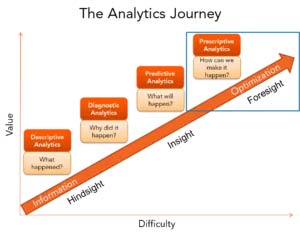Optimization: Moving from Insight to Actionable Foresight
Authored By Chris Long, Director of AMER Data Analytics Solutions Specialists, Business Intelligence Support for Altair
You’ve probably seen this chart or one like it recently:

Most organizations are finding their analytics efforts are somewhere between descriptive and predictive, few have been able to effectively move from only predictive to prescriptive and rely on rules of thumb or gut feel to apply analytic learnings. Many of those who’ve effectively moved into prescriptive analytics have started using segmentation tools like strategy trees. Strategy trees move organizations one step further up the chart adding to the concept of traditional decision trees in that they allow you to assign a treatment or action based on segments and dynamic key performance indicators. However, the organizations that have adopted pure mathematical optimization techniques are becoming firmly entrenched in the prescriptive stage of analytics purely because they’re reaping valuable benefits.
Optimization is a proven concept that can become a powerful planning tool helping you solve for the best possible outcome in a given business situation. Unlike traditional predictive modeling techniques that provide probabilities of an outcome, optimization builds on this giving the analyst or business user the ability to automatically embedded decisions maximizing or minimizing an objective. It can be applied across a broad range of business functions with some of the most successful use cases coming from risk, collections and marketing centers. Optimization strategies can be implemented at the macro and micro levels. For example, a marketer could ask at a departmental level, “Where should I focus my marketing dollars to get the best return? Events, digital, media or direct mail?” Or they could ask at a tactical level, “Which contact method is most likely to generate a response in this campaign? Call, text or email?”
A more technical definition would say that, optimization allows you to find the best values of decision variables to maximize an objective under business constraints. To add a little clarity, here are some examples of each of those key terms:
- Decision variables: Set of available treatments to cure a customer in arrears, channels used to contact the customer? Email, call, direct mail or text? Various marketing offers.
- Objective (Function): Maximize Campaign ROI, minimize risk, balancing siloed competing objectives.
- Constraints: Corporate contact policies, customer contacts, any planned or real world constraints that the business operates under. Channel capacities like call center, dialers, print houses, email/sms servers. Appetite for risk, provisions maximums for credit loss, budgets, regulatory compliance, fraud settings.
Given that optimization builds on and provides value above the standard predictive analytical practice, just what exactly will it do for your business? You can think of this in two ways, firstly the value in actionable reporting. Once you have run your optimization scenario you can clearly see the expected outcome and the impact on the various constraints in your business. Secondly, when you have a scenario that makes sense you can deploy IT as embedded decision logic into the various levels of your operations, and in effect operationalizing your insight. Optimization takes full advantage of your existing predictive models and will intelligently find the best possible answer to a strategic question instead of trying millions of permutation scenarios. Stakeholders in the business can then decide if constraints need to be imposed, tweaked or loosened based on expected outputs of optimization and scrutinize the set of specific actions at a customer level that can be translated directly to a deployment strategy.
In effect, making the decision to deploy all of your real-world business actions fully respecting requirements and constraints such as budgets, sequences, volumes and timing.
As the x-axis on the chart above illustrates, building on good data and analytics practices requires a greater level of effort and sophistication. At the same time though, the added value makes this effort worthwhile and offers the organization competitive advantages. Adoption of optimization offers significant lift in efficient utilization of resources whilst simultaneously maximizing business benefit. The right business action, at the right time, on the right channel to the right customer. Correct application of optimization will lead to embedded business decisions that are transparent, documented and truly provide benefit. This is an opportunity to establish a center of excellence at the forefront of value in analytical practices.
As with all things analytical the key to a successful implementation, is to find not just a provider, but a partner who not only has a strong software offering, but has the knowledge and experience to guide you through the process, make sure you are taking full advantage of the potential of optimization and when the time comes, provide the knowledge transfer required for your organizing to keep going.
Learn more about how Altair Knowledge Studio helps organizations make the move to prescriptive analytics with InsightOPTIMIZER.




